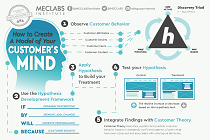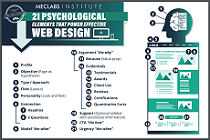
|
SUMMARY:
A muddled value proposition costs you leads, deals and revenue. In this article, we walk you through nine practical steps – grounded in real-world examples and Meclabs patented methodology – that will sharpen your message and boost conversions. |
Action Box: Stop Guessing – How to diagnose your value prop problems in 5 minutes
MeclabsAI can do it for you. Try the multi-agent protocol Is Your Value Prop Strong Enough? (MeclabsAI is MarketingSherpa’s parent company).
Start by auditing a key customer touchpoint – your homepage.
If you have the ability to get in front of your ideal customers in person (say at an industry event, maybe because they walk into your store, or because you do user testing), give the message on your homepage a five-second test. If they can’t articulate your main benefit after five seconds of looking at your homepage, you have work to do. Note where prospects hesitate and where your promise falters.
Even if you can’t get in front of the ideal customer, your own team can take a look at your homepage through the lens of Meclabs value proposition methodology, developed by Flint McGlaughlin.
Your value proposition (so by extension, your homepage) should answer the question, ‘If I am your ideal prospect, why should I buy from you rather than any competitor?’
The answer should have the following four elements. I put these elements in the order of how good marketers and entrepreneurs are at each one (in my personal opinion). In other words, we tend to be pretty good with appeal but struggle the most with credibility.
Appeal answers the prospect’s inner question: ‘What’s in it for me, right now?’ It hinges on three pillars:
Answers the prospect’s question: ‘Why should I buy from you and not anyone else?’ Key elements that make a product, service, or offer exclusive include:
Clarity answers the question: ‘Exactly what am I getting?’ To make sure your homepage, marketing message, or offer is clear, consider using:
Your customer is skeptical. They have been burned many times in the past. They have so many promises thrown at them every day by marketing messages. They will be asking: ‘Can I believe this will work for me?’ So remember to use:
As mentioned, if you have a homepage, that is a great place to evaluate your value proposition. But if you are a startup, you can even start evaluating that value prop before you build the homepage. Like this example…
“Getting our value proposition right was crucial to gaining traction in a competitive market dominated by Depop, Facebook Marketplace, and op shops [retailers of second-hand goods],” said Alon Dukorsky, founder, Circular Clothing Co.
The team felt that the product was already differentiated, but pre-launch feedback rated their value prop as not having any exclusivity and being ‘just another thrift store.’ They realized they just hadn’t nailed how to communicate that differentiation yet. “That’s what the early feedback showed us: we didn’t need to reinvent the offering, we needed to reframe the perception,” he said.
To better understand where their product stood as it related to customer expectations, they researched their market. “We ran a wide online survey by posting in Gen Z fashion Facebook groups, Reddit threads, and niche resale communities,” Dukorsky explained.
They ended up with over 800 responses, which gave them a clear sense of what people actually wanted (and what they were sick of). “We tagged common themes in Notion,” he said. Top issues were lack of trust, too much friction when listing, and unclear brand identity. This helped them evaluate where their brand’s value prop stood in comparison to their ideal customers’ expectations.
But those expectations don’t exist in a vacuum. So on to Step #2.
Your appeal is not fixed, it’s relative to the other options your ideal customer has in the marketplace. And obviously, your exclusivity depends on those other options as well.
So identify your top three to five most significant competitors. Go to their homepage. Capture their headlines, sub-headlines and proof points.
Rate the strengths and weaknesses of every element of their value proposition. Now, take another look at your own brand’s value proposition based on what you just learned.
For example, to learn about its B2C competitors, Dukorsky and the team at Circular Clothing relied on “mostly Trustpilot reviews and Reddit threads.” Here’s another example, this one from the world of B2B…
An enterprise healthcare compliance software company wanted to target more mid-size and larger businesses.
“We conducted a competitor analysis to understand how competitors are communicating value. We learned that our client was focused more on product and features rather than customer benefits when compared to competitors,” explained Graham Ericksen, partner & chief strategy officer, Modus.
To discover those benefits, the team asked key stakeholders:
‘All-in-one solution’ and ‘healthcare industry-specific solution’ kept coming up. The team focused on this position with more customer-benefit-focused messaging.
Creative Sample #1: Previous homepage meta description
Award-Winning Enterprise Healthcare Compliance Software
Creative Sample #2: New homepage meta description
See how our all-in-one enterprise healthcare compliance software automates compliance, credentialing, and learning. For companies with up to 5,000 employees.
This messaging change helped lead to a 3% conversion rate increase, with conversion defined as clicks on a CTA.
In addition to keeping an eye on your competitors, you want to keep an eye on the overall marketplace as well. So on to the next step.
Your value proposition is currently in flux because your competitors are changing, but the markets and macroeconomic environments in many industries are rapidly changing as well.
To use an overly simplistic example, let’s say you sell umbrellas. Your sales could drop if your competitor comes out with a lighter weight model at a lower price, perhaps. But regardless of what your competitors do, your sales could also drop if it stops raining.
If you tracked emerging trends, you could see a drought coming before it hits. And you could shift your messaging and make product tweaks (white reflective umbrellas instead of black) to focus on keeping a different ideal customer cool and shaded in the blinding sun and relentless heat of that drought.
Regularly generate an industry trends and outlook report that analyzes how the force of your brand’s value prop will grow or diminish
Gather monthly intel from industry newsletters, analyst reports and webinars. Identify three trends – for example, in the marketing industry those trends might be AI automation, privacy regulations, and mobile UX – and grade each for relevance and urgency.
You might even want to assign a team member to maintain a rolling ‘Trend Impact Dashboard’ in your wiki. Or if you’re an agency, include it in quarterly updates to the client where you’re discussing what’s working and what’s not right now.
The team at Circular turned to social media to spot trends. “TikTok showed us early on that things were shifting from guilt-driven sustainability content to style-first thrift hauls – fun, aspirational, and self-expressive,” Dukorsky said.
But they’re careful not to fall for one-off virality. “We look for repeat signals across TikTok, Pinterest, and niche-style communities,” he said. If a trend appears across three or more of those, it’s probably worth testing.
As a marketing leader, agency executive, or even CEO of your company – you alone do not own your value proposition. The entire company does. So it’s important to get all key stakeholders involved in strengthening your value proposition. Don’t just take it from me. I’ve been told this time and again on How I Made It In Marketing:
So while you might not be the sole owner of the value proposition, you certainly can be the shepherd. At this point you have conducted an evaluation of your brand’s value prop, the strengths and weaknesses of competitors in the marketplace, and have an understanding of where the market is moving.
Put all of this into a slide deck and host a focused 45-minute workshop with marketing, sales and product stakeholders. Present your audit and competitor insights. Have some time to white space and brainstorm, collate what you discussed, then send out a simple poll to vote on the most compelling elements to highlight so your brand communicates appeal clearly, with credibility and exclusivity. And craft that new value proposition using the same elements discussed in Step #1.
And then keep the conversation going. Dukorsky said his team’s stakeholder feedback process was “Mostly async – Slack threads, Loom walkthroughs, and Notion comments. Screenshot sharing and Looms worked best.”
At this point you have met with stakeholders to come up with some ideas (hypotheses) for changes you want to make to your brand’s value proposition. In most organizations, now it’s time to move from that strategic group (usually leaders from the company and agency partners) to the team that will execute on these changes (like writers, designers, and even AI).
When you inform the creative/execution team about these changes, it helps for them to have context about key elements of your brand, that new value proposition, and how your homepage is currently setup (so they can propose changes). An example of this is the Master Context Document used by MeclabsAI. It could include:
Whatever format you choose to centralize insights, make sure all key players on your team have access. “We use Notion as our central hub – it works as a research library, messaging guide, content tracker, and brand playbook all in one,” Dukorsky said.
For example, he explained “Our content team was planning a Y2K campaign and, before creating assets, checked our ‘Trend Signals’ doc in Notion.” Turns out, the merch team had already flagged 2000s-inspired denim and micro bags as top performers in recent drops. That alignment sped things up, and the campaign ended up triggering a spike in conversions and three new sellers requesting clean-out kits within 72 hours of launch.
Once the team has an idea of the audience and user segments, they want to go deeper here while working on the creative and define an Initial Customer Profile (ICP). What is the customer’s day-to-day reality? Their hair-on-fire pains? Deep fears? Buying triggers?
This type of information will help you better serve your ideal customer, which translates into a more effective value proposition. Because remember, a value proposition is value for an ideal customer. Whether that value is appealing or unappealing will vary based on who the customer is. The more tightly you narrow who the customer is, the more powerful your value prop can be.
As mentioned previously, the team at startup Circular Clothing had a pre-launch survey. “We posted in Facebook uni groups, niche Reddit threads, and Instagram stories – no paid ads, just early hype,” Dukorsky said.
Off these pre-launch surveys, the team built initial customer profiles that included, for example, shopping habits (“Mixes vintage with high street, scrolls TikTok for outfit inspo, buys resale for price and uniqueness, not guilt”) and why she shops Circular (“She wants resale to feel more like Pinterest, less like a secondhand bin – and Circular nails that.”).
The team revisited and refined this ICP once they launched the business. “We track quiz data, Shopify patterns, and recurring themes in TikTok comments and DMs,” Dukorsky explained.
While Circular started with pre-launch surveys, if you’re a more established business you likely have data to work with right now to craft an ICP. Like in our next example.
“We identified an exact customer to find a solution to our poor value proposition,” said Jason Rowe, director & founder, Hello Electrical. “It is a prevalent belief within most service contexts that defining a large demographic like ‘homeowners’ is enough. By specifying a large demographic classification, we lose all the subtleties that exist within demographics that are often seen as similar.”
The team reviewed service call logs, customer satisfaction surveys, their highest-rated reviews, and return business. This data helped them narrow their ideal customer to ‘busy professional homeowners’ and ‘young family homeowners.’
They listened to common questions during service calls from this narrower ideal customer – for example, ‘Is this safe for the kids?’ And they conducted 72 in-depth phone interviews over three months with previous customers.
The team changed their message from focusing on solving electrical problems to offering peace of mind. That is a spontaneous phrase that came out of the customer interviews.
They carried out a two-month A/B test on the confirmation messages sent online and subsequent follow-up emails and saw a 10-percent increase in engagement from the new messaging.
Some tactics that worked well according to the testing include:
So on to the nest step – testing.
Now you have a lot of info about your ideal customer, where the marketing is heading, etc. It’s time to get creative.
But don’t stop at just one idea. All of this background work should give you a lot of ideas. So develop three or more variants to test via email, ads, or landing pages.
“We A/B tested taglines and visuals across Instagram and email, refined our on-site messaging,” Dukorsky said. “‘Smarter resale. No cringe thrift vibes.’ with a clean flatlay image performed best in our Instagram ad tests.”
Creative Sample #3: Traditional tone in Instagram ad
‘Shop sustainable fashion’ headline using a styled model shot.

Creative Sample #4: Self-aware, meme-friendly tone in Instagram ad
‘Smarter resale. No cringe thrift vibes.’ with a clean flatlay image.

The meme-friendly tone lifted CTR by 29%.
In email subject lines, the team tested tone (playful got more opens than direct).
Creative Sample #5: Email subject line – platyful tone

They also tested urgency (FOMO got more opens than chill).
Creative Sample #6: Email subject line – urgency tone

In ad copy tests, ‘no listing stress’ and ‘smarter resale’ consistently outperformed anything that focused on low prices or huge variety.
Creative Sample #7: Video ad with scrolling products focused on low prices and huge variety

Creative Sample #8: 'No listing stress' ad

The fashion resale platform launched in May 2025 and has already attracted more than 26,000 site visits, 4,000 listed items, and a waitlist for clean-out kits.
At this point, pop the champagne and celebrate. You have landed on an effective way to share the unique, appealing value your company creates.
Now tell the world (well, your ideal customers in the world). Refresh your homepage hero. Add a one-minute explainer video showing (not telling) your shiny new value prop in action. Launch a new demo webinar. Highlight quantitative proof: ‘Restore data in under 60 seconds.’
All of the marketing tactics you’ve been using – only now more effective, since you’re doing a better job of communicating value.
The previous step was the climax of this story, but don’t overlook the denouement. And not just any denouement…because this story has a sequel. And that sequel is the fact that your business is a going concern. So you can’t just bring the proposition to life and that’s it. Just like when you bring a human to life, you are responsible for this value proposition for 18 years and counting.
So while you have launched new, more effective messaging…don’t rest on your laurels.
There will always be unresolved questions and emerging threats. How do you enable every stakeholder (from internal teams to external vendors to business partners) to communicate and deliver on the new value proposition? How do you make sure this is not just a one and done improvement?
To transition smoothly into the new value prop, first of all, make sure everyone working on your brand has a keen understanding of what a value proposition is. Then, clearly communicate to all stakeholders (sometimes this is following up with them after their initial input) where the brand’s value prop has landed.
You could publish a one-page value proposition style guide. You could train sales and support teams in a 15-minute session. You could include example scripts and objection-handling tips that reinforce your new message.
Here’s a great example.
The team created a new value prop that focused on a private equity firm as the bridge between trust and innovation.
To roll it out “partner talking points, portfolio narratives, and positioning materials were rebuilt around Phoenix Equity Partners as a bridge between trust and innovation,” explained Jack Goodson, founder & CEO, The Identity Consultants.
The team developed a full 50-page brand book that rebuilt every touchpoint around the new identity:
Partners received one-to-one narrative mirroring sessions to help them rewrite their elevator pitch and communicate the new strategy. The team built mini narrative cue cards – reframing tools for pitches, founder meetings, and investor updates.
The private equity firm raised £600M in funds in 2024. “While correlation does not equal causation, the partners cited narrative clarity and emotional resonance as key differentiators during the limited partner process and at Phoenix’s annual investor conference,” he said.
There you have it – nine steps to help strengthen your brand’s value proposition. And if you need help, just try the Is Your Value Prop Strong Enough? multi-agent protocol workflow from MeclabsAI, MarketingSherpa’s parent company.
This article was distributed through the MarketingSherpa email newsletter.
AI Hackathon: Build a powerful lead gen agent in just 90 minutes – Join us on Wednesday, July 30th from 2 to 3:30 pm EDT
Value Proposition Definition: Optimize your conversion rate with this powerful question
Value Proposition Danger: If you make this mistake your offer’s value does not matter
Value Proposition Credibility: 3 ways to help people instantly believe your message
Transparent Marketing: How to make your product claims credible … not incredible
Get Better Business Results With a Skillfully Applied Customer-first Marketing Strategy

The customer-first approach of MarketingSherpa’s agency services can help you build the most effective strategy to serve customers and improve results, and then implement it across every customer touchpoint.
Get More Info >MECLABS AI

Get headlines, value prop, competitive analysis, and more.
Use the AI for FREE (for now) >Marketer Vs Machine

Marketer Vs Machine: We need to train the marketer to train the machine.
Watch Now >Live, Interactive Event

Join Flint McGlaughlin for Design Your Offer on May 22nd at 1 pm ET. You’ll learn proven strategies that drive real business results.
Get Your Scholarship >Free Marketing Course

Become a Marketer-Philosopher: Create and optimize high-converting webpages (with this free online marketing course)
See Course >Project and Ideas Pitch Template

A free template to help you win approval for your proposed projects and campaigns
Get the Template >Six Quick CTA checklists

These CTA checklists are specifically designed for your team — something practical to hold up against your CTAs to help the time-pressed marketer quickly consider the customer psychology of your “asks” and how you can improve them.
Get the Checklists >Infographic: How to Create a Model of Your Customer’s Mind

You need a repeatable methodology focused on building your organization’s customer wisdom throughout your campaigns and websites. This infographic can get you started.
Get the Infographic >Infographic: 21 Psychological Elements that Power Effective Web Design

To build an effective page from scratch, you need to begin with the psychology of your customer. This infographic can get you started.
Get the Infographic >Receive the latest case studies and data on email, lead gen, and social media along with MarketingSherpa updates and promotions.